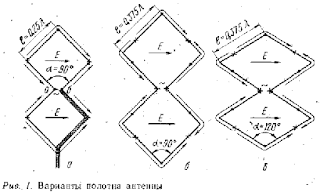I am 12-17 km from the nearest 3G Ukrtelecom UMTS cell tower. My 3G modem Huawei E1550 is in the attic with the wifi router.
After lots of experimenting with integrated and external monopole, dipole, modified dipoles I finally tried an antenna well known to ex-USSR amateur radio guys. The antenna is called "Kharchenko's Antenna". It is a kind of a looped dipole, but squared, with some oversizing giving it interesting gain and impedance characteristics.
The antenna was introduced for 3G by http://vov-anuch.narod.ru/rasch.html and I have to express my gratitude to the person for bringing this 1967 (!) stuff up back to life. The description is there, along with scans from "Radio" of 1966-1967 with impedance, gain and standing wave curves.
I let myself reproduce the drawings and curves here:
It does not requre a transformer or a balun - with impedance ca 100 Ohm. (Should mind though that is made 0,25 wavelength per square's side, it becomes a classic folded 300Ohm dipole, that dues require a transformer).
My connection to the modem is rather rough - because I manage to break all the good circuity - so I attached the coax' core to the pin #10 of the radio unit IC AFEM-7780 Avago - 50 Ohm impedance at the antenna pin:
The gain over a monopole is 6db (which is hard to believe with my "accuracy" of implementation, but the modem measures so), and it is perfect both for vertical and horizontal polarization (I found out by experimenting with a dipole that upling and downlink signals of the UMTS cell use different poarization).
Very stable connection, with the cell not overloaded by users giving the full 2mbps/0,2mbs down/uplink HSDPA.
Those who wish to read (Google-translate) the Kharchenko's (the author's) alternative electromechanics theory may get it here: http://ehant.qrz.ru/harchenko.htm
Enjoy!
P.S. Some more practical biquad antenna advice with pictures can be found here: http://radiowolna.narod.ru/bikwadrat.html
After lots of experimenting with integrated and external monopole, dipole, modified dipoles I finally tried an antenna well known to ex-USSR amateur radio guys. The antenna is called "Kharchenko's Antenna". It is a kind of a looped dipole, but squared, with some oversizing giving it interesting gain and impedance characteristics.
The antenna was introduced for 3G by http://vov-anuch.narod.ru/rasch.html and I have to express my gratitude to the person for bringing this 1967 (!) stuff up back to life. The description is there, along with scans from "Radio" of 1966-1967 with impedance, gain and standing wave curves.
I let myself reproduce the drawings and curves here:
l/d is square's side to wire diameter ratio. l/Lambda is squares' side to wavelength.
I actually used thin wire i.e. l/d of 120 or so, and the l/Lambda ratio of 0,28. I did not strive for the best of gain, rather wanted to be on a steeper paer of the curve as UMTS has rather wide frequency range, and lower impedance to match the RF unit of the E1550.
My dimention for the squares' sides is 37mm. I calculated it as: 286 the speed of em waves / 2170 Mhz tomes the 0,28 ratio (instead of the 0,375 ratio used by the original).
I also attached a reflector spaced by quarter-wave, actually a CD.
The resulting antenna looks like this:
My connection to the modem is rather rough - because I manage to break all the good circuity - so I attached the coax' core to the pin #10 of the radio unit IC AFEM-7780 Avago - 50 Ohm impedance at the antenna pin:
The gain over a monopole is 6db (which is hard to believe with my "accuracy" of implementation, but the modem measures so), and it is perfect both for vertical and horizontal polarization (I found out by experimenting with a dipole that upling and downlink signals of the UMTS cell use different poarization).
Very stable connection, with the cell not overloaded by users giving the full 2mbps/0,2mbs down/uplink HSDPA.
Those who wish to read (Google-translate) the Kharchenko's (the author's) alternative electromechanics theory may get it here: http://ehant.qrz.ru/harchenko.htm
Enjoy!
P.S. Some more practical biquad antenna advice with pictures can be found here: http://radiowolna.narod.ru/bikwadrat.html




